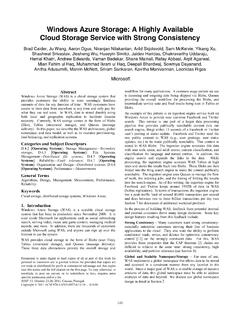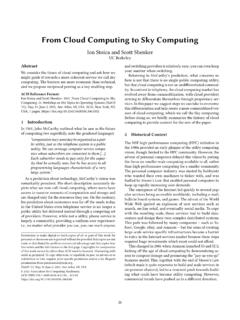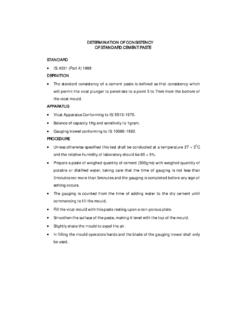Transcription of Windows Azure Storage: A Highly Available Cloud …
1 Windows Azure storage : A Highly Available Cloud storage Service with Strong consistency Brad Calder, Ju Wang, Aaron Ogus, Niranjan Nilakantan, Arild Skjolsvold, Sam McKelvie, Yikang Xu, Shashwat Srivastav, Jiesheng Wu, Huseyin Simitci, Jaidev Haridas, Chakravarthy Uddaraju, Hemal Khatri, Andrew Edwards, Vaman Bedekar, Shane Mainali,Rafay Abbasi, Arpit Agarwal, Mian Fahim ul Haq, Muhammad Ikram ul Haq, Deepali Bhardwaj, Sowmya Dayanand, Anitha Adusumilli, Marvin McNett, Sriram Sankaran, Kavitha Manivannan, Leonidas Rigas Microsoft Abstract Windows Azure storage (WAS) is a Cloud storage system that provides customers the ability to store seemingly limitless amounts of data for any duration of time. WAS customers have access to their data from anywhere at any time and only pay for what they use and store.
2 In WAS, data is stored durably using both local and geographic replication to facilitate disaster recovery. Currently, WAS storage comes in the form of Blobs (files), Tables (structured storage ), and Queues (message delivery). In this paper, we describe the WAS architecture, global namespace, and data model, as well as its resource provisioning, load balancing, and replication systems. Categories and Subject Descriptors [Operating Systems]: storage Management Secondary storage ; [Operating Systems]: File Systems Management Distributed file systems; [Operating Systems]: Reliability Fault tolerance; [Operating Systems]: Organization and Design Distributed systems; [Operating Systems]: Performance Measurements General Terms Algorithms, Design, Management, Measurement, Performance, Reliability.
3 Keywords Cloud storage , distributed storage systems, Windows Azure . 1. Introduction Windows Azure storage (WAS) is a scalable Cloud storage system that has been in production since November 2008. It is used inside Microsoft for applications such as social networking search, serving video, music and game content, managing medical records, and more. In addition, there are thousands of customers outside Microsoft using WAS, and anyone can sign up over the Internet to use the system. WAS provides Cloud storage in the form of Blobs (user files), Tables (structured storage ), and Queues (message delivery). These three data abstractions provide the overall storage and workflow Permission to make digital or hard copies of all or part of this work for personal or classroom use is grantedwithout fee provided that copies are not made or distributed for profit or commercial advantage and that copiesbear this notice and the full citation on the first page.
4 To copy otherwise, to republish, to post on servers or to redistribute to lists, requires prior specific permission and/or a fee. SOSP '11, October 23-26, 2011, Cascais, Portugal. Copyright 2011 ACM 978-1-4503-0977-6/11/10 .. $ many applications. A common usage pattern we see is incoming and outgoing data being shipped via Blobs, Queues providing the overall workflow for processing the Blobs, and intermediate service state and final results being kept in Tables or Blobs. An example of this pattern is an ingestion engine service built on Windows Azure to provide near real-time Facebook and Twitter search. This service is one part of a larger data processing pipeline that provides publically searchable content (via our search engine, Bing) within 15 seconds of a Facebook or Twitter user s posting or status update.
5 Facebook and Twitter send the raw public content to WAS ( , user postings, user status updates, etc.) to be made publically searchable. This content is stored in WAS Blobs. The ingestion engine annotates this data with user auth, spam, and adult scores; content classification; and classification for language and named entities. In addition, the engine crawls and expands the links in the data. While processing, the ingestion engine accesses WAS Tables at high rates and stores the results back into Blobs. These Blobs are then folded into the Bing search engine to make the content publically searchable. The ingestion engine uses Queues to manage the flow of work, the indexing jobs, and the timing of folding the results into the search engine.
6 As of this writing, the ingestion engine for Facebook and Twitter keeps around 350TB of data in WAS (before replication). In terms of transactions, the ingestion engine has a peak traffic load of around 40,000 transactions per second and does between two to three billion transactions per day (see Section 7 for discussion of additional workload profiles). In the process of building WAS, feedback from potential internal and external customers drove many design decisions. Some key design features resulting from this feedback include: Strong consistency Many customers want strong consistency : especially enterprise customers moving their line of business applications to the Cloud . They also want the ability to perform conditional reads, writes, and deletes for optimistic concurrency control [12] on the strongly consistent data.
7 For this, WAS provides three properties that the CAP theorem [2] claims are difficult to achieve at the same time: strong consistency , high availability, and partition tolerance (see Section 8). Global and Scalable Namespace/ storage For ease of use, WAS implements a global namespace that allows data to be stored and accessed in a consistent manner from any location in the world. Since a major goal of WAS is to enable storage of massive amounts of data, this global namespace must be able to address exabytes of data and beyond. We discuss our global namespace design in detail in Section 2. Disaster Recovery WAS stores customer data across multiple data centers hundreds of miles apart from each other. This redundancy provides essential data recovery protection against disasters such as earthquakes, wild fires, tornados, nuclear reactor meltdown, etc.
8 Multi-tenancy and Cost of storage To reduce storage cost, many customers are served from the same shared storage infrastructure. WAS combines the workloads of many different customers with varying resource needs together so that significantly less storage needs to be provisioned at any one point in time than if those services were run on their own dedicated hardware. We describe these design features in more detail in the following sections. The remainder of this paper is organized as follows. Section 2 describes the global namespace used to access the WAS Blob, Table, and Queue data abstractions. Section 3 provides a high level overview of the WAS architecture and its three layers: Stream, Partition, and Front-End layers. Section 4 describes the stream layer, and Section 5 describes the partition layer.
9 Section 6 shows the throughput experienced by Windows Azure applications accessing Blobs and Tables. Section 7 describes some internal Microsoft workloads using WAS. Section 8 discusses design choices and lessons learned. Section 9 presents related work, and Section 10 summarizes the paper. 2. Global Partitioned Namespace A key goal of our storage system is to provide a single global namespace that allows clients to address all of their storage in the Cloud and scale to arbitrary amounts of storage needed over time. To provide this capability we leverage DNS as part of the storage namespace and break the storage namespace into three parts: an account name, a partition name, and an object name. As a result, all data is accessible via a URI of the form: http(s)://AccountName.<service> The AccountName is the customer selected account name for accessing storage and is part of the DNS host name.
10 The AccountName DNS translation is used to locate the primary storage cluster and data center where the data is stored. This primary location is where all requests go to reach the data for that account. An application may use multiple AccountNames to store its data across different locations. In conjunction with the AccountName, the PartitionName locates the data once a request reaches the storage cluster. The PartitionName is used to scale out access to the data across storage nodes based on traffic needs. When a PartitionName holds many objects, the ObjectName identifies individual objects within that partition. The system supports atomic transactions across objects with the same PartitionName value. The ObjectName is optional since, for some types of data, the PartitionName uniquely identifies the object within the account.










